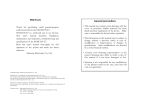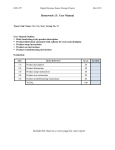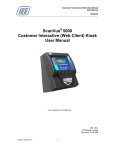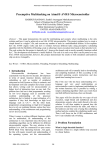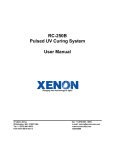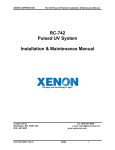Download Design Project
Transcript
ECE 477 Digital Systems Senior Design Project Rev 9/12 Homework 12: Environmental Impact Lifecycle Analysis and Ethical Challenges Team Code Name: Team Hex Me Baby Group No. 3 Team Member Completing This Homework: Spencer Julian E-mail Address of Team Member: [email protected] NOTE: This is the last in a series of four “professional component” homework assignments, each of which is to be completed by one team member. The body of the report should be 3-5 pages, not including this cover page, references, attachments or appendices. Evaluation: SEC DESCRIPTION MAX 1.0 Introduction 5 2.0 Environmental Impact Analysis 40 3.0 Ethical Challenges 40 4.0 Summary 5 5.0 List of References 10 TOTAL 100 Comments: SCORE ECE 477 Digital Systems Senior Design Project Rev 9/12 1.0 Introduction The Hackers of Catron is an electronic version of the popular board game, the Settlers of Catan. The game is a resource trading game with the goal of getting the most points by having the most cities and villages placed on the playing surface. The electronic version of this game is built using a large printed circuit board and several other components which react to magnets and is housed in an acrylic package. As one might imagine, there are a few environmental concerns to be dealt with, not to mention the ethical implications of some of the components and of the environmental concerns themselves. While the product should last a relatively long time, as there are few moving parts and it requires very little maintenance, it will still likely need to be disposed of at some point, and some special considerations come into play there. 2.0 Environmental Impact Analysis The obvious first concern for any device is the creation of the device itself. In the case of the Hackers of Catron, there is a large printed circuit board along with several electronic components which have special considerations. Additionally, the packaging and the pieces themselves should be considered. The printed circuit board is an obvious source of concern to anyone familiar with how they are made [1]. The board requires the use of various hazardous materials that are not easy to dispose of in any way [2]. Ideally, these would be reused as much as possible, but considering that these chemicals have a limited number of times they can be reused, they will need to be disposed of at some point. Reducing the use of the chemicals may help. In order to reduce the use of the chemicals, we could shrink the size of the PCB some or re-design the board such that it does not use a large PCB, but uses a small one with some interconnecting wire or something of the sort connecting to the Hall Effect sensors, LEDs, and the like. This has other technical issues but those are outside the scope of this report. The use of some of these chemicals will be necessary no matter what we do, but reducing their use can help with environmental concerns. The printed circuit board isn’t the only electronic component we need to worry about, however. Many of the integrated circuits on the device, such as the microcontroller and the drivers, are manufactured using similarly environmentally unfriendly processes [5]. Unfortunately, the only real way to alleviate this would be to go to another manufacturer or try to convince the manufacturer of the chips to change their manufacturing process. Considering the majority of manufacturers use similar processes, there is little that can be done. It may be possible to minimize the use of these devices by redesigning the board, but other than selecting manufacturers carefully and completely redesigning, there is little else to be done. As far as the packaging is concerned, acrylic, abs, metal, and wood are the primary components. Wood, given it comes from environmentally sustainable wood, is not a concern. Acrylic and ABS are the biggest concerns. The ABS could be replaced with corn-based PLA, which could possibly increase costs but be much more sustainable and biodegradable [6][7]. Acrylic is derived from petroleum, a fossil fuel, which is generally regarded as being environmentally unfriendly [3]. The best option for this would be to use as much recycled plastic as possible. Everything to now only considers the manufacture of the device, however. While general use is not a concern outside of power usage, as the device has no moving parts and requires little maintenance, disposal of the device in its current form could be a challenge to a user. There are -1- ECE 477 Digital Systems Senior Design Project Rev 9/12 several pieces to consider, including the PCB, the packaging, and other electronics not mentioned to this point, such as the Raspberry Pi. The circuit board and the electronics on the board are the most obvious concern. PCBs are not inherently biodegradable, and there is little that can be done about that. The best way to dispose of the circuit board would be to send the device to an electronics recycler. As e-waste is becoming more of a concern in the mind of the average, moderately well-educated citizen, there are more recycling centers popping up in relatively well-populated areas, and there are website such as 1800recycling.com that can assist users in their search [8]. The user manual can advertise one of these sites. Additionally, if the product is being manufactured, the manufacturer can receive products from users and send them off to an appropriate electronics recycler after harvesting any parts that could be used for a refurbished device. In addition to the electronics and the PCB, we are using a Raspberry Pi as a web server, which is an independent device of its own. The pi has its own concerns, however as the pi should not fail sooner than the primary PCB, it can likely be used in refurbished versions of the device if it were sent back to the manufacturer, or even harvested by the user for their own use. If the pi were to fail, it is unlikely that the SD Card that the pi runs off of would fail, so at the very least that could be reused. If it were to be disposed, it would need to be disposed in a similar way to the PCB itself, going through an electronics recycler. Of course, in order to connect the Raspberry Pi to the PCB, there are a few wires, but these can be reused or will be taken care of by the electronics recycler. Outside of the board itself, there are also the pieces and the packaging. As far as the pieces go, they are made of wood with magnets glued to them. The magnets must be disposed of in a very particular way – in many places there are specific requirements, but usually it is safe to put them in a metallic box to dispose of them [9]. They can also be re-used if they are still magnetic, or if not, the metal may be able to be reclaimed. Generally, if the device is sent to an electronics recycler, the pieces should be as well, and the recycler will be able to take care of the magnets. The wooden parts of the pieces are biodegradable, and can be reused in various ways. If they are in decent condition when returned to the manufacturer, they can even be reused in refurbished products. The packaging is a large concern as well. The device is contained in a large, acrylic hexagon box. The box is held together with acrylic glue. Additionally, there are ABS hexagons and washers glued to the top of the box, and hinges glued to the bottom. None of these things are biodegradable by any stretch of the imagination, however they are recyclable and reusable [4] [6]. The packaging can be recycled separately from the electronics at a standard recycling plant, as the glue should be removable with a specific compound. Of course, the compound may not be environmentally friendly itself, so it would also need to be disposed of properly. When all the pieces are separated, all of the metal and plastic can be reclaimed. If sent back to the manufacturer, it could even be refurbished. Should the ABS be replaced with PLA, it would be biodegradable and easy to simply throw away [7]. If the user opted to keep the packaging, it could make a nice flower bed. Even with all these nice things that can be done with the product, there is nothing stopping the consumer from taking the easy route and just throwing the device away. That can be deterred to some extent by placing appropriate warnings in the user manual, or by offering an incentive to consumers who ship the device back for recycling, such as offering 20% off their next purchase from the manufacturer or something to that effect. -2- ECE 477 Digital Systems Senior Design Project Rev 9/12 3.0 Ethical Challenges Ethically, there isn’t much that can go wrong with the product, but there is always the possibility for concern. The device itself is quite large and cumbersome, and there are lots of small pieces that could post safety risks, for example. Additionally, there is a security risk involved with the Raspberry Pi. Generally, these cannot be mitigated, but proper warning and usage can reduce the chance of anything unfortunate happening. Starting with the obvious, the device is electronic. Most electronic devices have the possibility for electric shock and burn, just from being there, as there is the possibility of a malfunction on the device which could cause a dangerous situation. For this situation, it would be best to have appropriate voltage and current ratings printed on the board near the power connector, along with a safety warning nearby warning not to poke around in the device for the same reasons. On top of the electrical concerns, there are concerns with the size of the device and with the small pieces. The device should not be marketed to people under 14 years of age due to the magnets, and appropriate safety warnings in the user manual should note that there are small pieces with the device and they should not be anywhere near children. There are also pinch hazards that go along with magnets, and of course concerns with carrying the physical device, so there should be warnings to have the device on a balanced surface and to be careful when picking up and moving the device. The magnets can be stored on a metal plate with beveled or plastic-coated edges that can be shipped with the device, if it were to go to market. The device has a large number of LEDs, and if the device is used improperly or if the device malfunctions, they could flash at a high frequency and cause seizures in photosensitive individuals with epileptic tendencies. In order to help reduce the likelihood of this scenario occurring, the best option would be yet another warning in the user manual and on the device itself warning of the effects of high frequency strobe lights on such individuals. There are also concerns with security when the Raspberry Pi is brought into the picture. Because the Raspberry Pi is running an open Wi-Fi Access Point, sensitive information should not be transmitted over it. Generally this should not be a concern when the device is not attached to an external network, as there is nothing other than the web interface for the device that can be accessed. However, if the device is connected to a network, then the possibility exists for a device in promiscuous mode not connected to the Pi to sniff traffic and obtain sensitive information. In order to warn the user, there should be a user manual warning and a warning upon connection to the device. Additionally, a future iteration of the product could include the capability to set up a WPA or WEP encrypted network. While using a network encrypted in this way does not mitigate all risk, it does reduce it greatly [10]. Finally there is the concern with overuse of the device. If the device is used for long periods of time, it could be unhealthy for the players and possibly harmful for the device. A brief warning in the user manual to take breaks from the game every few hours would likely be sufficient in mitigating this risk, though more extreme measures such as turning the device off after a set period of time could completely remove this risk. -3- ECE 477 Digital Systems Senior Design Project Rev 9/12 4.0 Summary The Hackers of Catron will be an incredibly fun game, but through its lifecycle there are a few reasonable concerns. Manufacturing involves some nasty chemicals and methods that may not be completely safe for the environment. Additionally, the product is essentially one giant PCB wrapped in plastic with a bunch of small pieces, so disposal is not easy either. The best way to dispose of the game would be to recycle it, of course, but in order to ensure the consumer does so there may need to be some sort of incentive to do so. Even outside of the environmental concerns, there are ethical concerns with safety and security. Many of the safety concerns are similar to most other electronic devices and magnetic pieces on the market. The security concerns could be slightly reduced if proper encryption were added to the wireless network, but using a wireless network is inherently less safe than using a wired network, so the concerns will never be resolved. Ideally, many of the safety and security concerns could be mitigated using lots of warning labels. -4- ECE 477 Digital Systems Senior Design Project Rev 9/12 5.0 List of References [1] Wikipedia, “Printed circuit board,” 5 4 2013. [Online]. Available: http://en.wikipedia.org/wiki/Printed_circuit_board. [Accessed 10 4 2013]. [2] Environmental Resource Site for SME Manufacturers, “Overview of Printed Circuit Board Industry,” 2007. [Online]. Available: http://www.sme.greenmfr.org/english/printed/printed.html. [Accessed 10 4 2013]. [3] Wikipedia, “Poly(methyl methacrylate),” 9 4 2013. [Online]. Available: http://en.wikipedia.org/wiki/Acrylic_glass. [Accessed 10 4 2013]. [4] Acrylite, “Acrylite LED color-changing back lit (black/white P95),” [Online]. Available: http://www.acrylite-shop.com/pdfs/3667a%20P95%20Black%20and%20White%20sell%20sheet.pdf. [Accessed 10 4 2013]. [5] Wikipedia, “Integrated Circuit,” 6 4 2013. [Online]. Available: https://en.wikipedia.org/wiki/Integrated_circuit. [Accessed 10 4 2013]. [6] Wikipedia, “Acrylonitrile butadiene styrene,” 12 3 2013. [Online]. Available: http://en.wikipedia.org/wiki/Acrylonitrile_butadiene_styrene. [Accessed 10 4 2013]. [7] Wikipedia, “Polylactic acid,” 3 1 2013. [Online]. Available: http://en.wikipedia.org/wiki/Polylactic_acid. [Accessed 10 4 2013]. [8] 1800Recycling.com, “1800Recycling.com,” 2013. [Online]. Available: http://1800recycling.com/. [Accessed 10 4 2013]. [9] Magnetic Component Engineering, “Disposal of Magnets…,” 2009. [Online]. Available: http://www.mceproducts.com/knowledge-base/article/article-dtl.asp?id=11. [Accessed 10 4 2013]. [10] Lifehacker, “How to Crack a Wi-Fi Network’s WPA Password with Reaver,” 9 1 2012. [Online]. Available: http://lifehacker.com/5873407/how-to-crack-a-wi+fi-networks-wpapassword-with-reaver. [Accessed 10 4 2013]. -5- ECE 477 Digital Systems Senior Design Project -6- Rev 9/12








